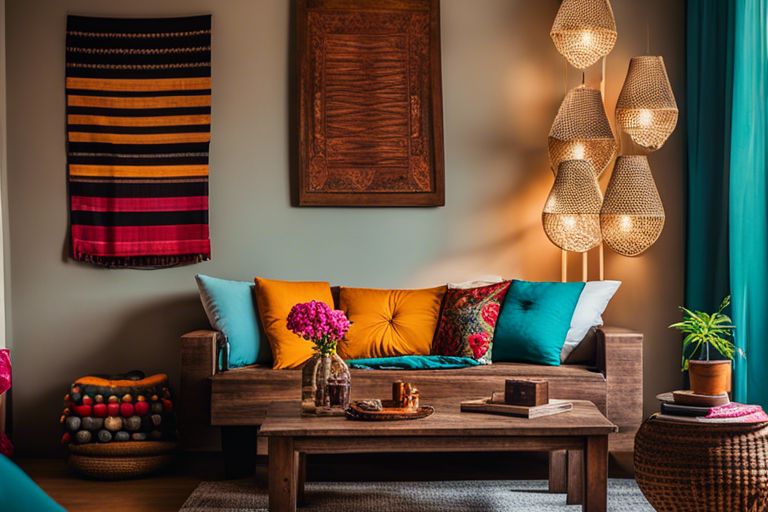Are you tired of the same old interiors in your urban Indian home? It’s time to think outside the box and embrace the art of reusing, recycling, and upcycling to transform your space into a unique and sustainable haven. In this guide, we’ll provide you with expert tips and tricks on how to incorporate these eco-friendly practices into your interior design, creating a space that’s not only stylish but also environmentally conscious. Get ready to unleash your creativity and give your home a fresh, one-of-a-kind look by incorporating these innovative ideas. And if you’re looking for more inspiration, be sure to check out our article on the Top 8 Creative Upcycled Home Decor Ideas to kickstart your DIY journey.
Table of Contents
Key Takeaways:
- Embrace Sustainability: Reusing, recycling, and upcycling items in your urban Indian interiors can help reduce waste and contribute to a more sustainable lifestyle.
- Be Creative and Resourceful: Look for unique ways to repurpose old items and give them new life in your home decor. This can include anything from furniture to art or even household items.
- Support Local Artisans: Consider buying handmade or locally crafted items for your home, supporting the local economy while adding character to your space.
Understanding the Basics
Obviously, before you start transforming your space with sustainable materials and DIY projects, it’s important to understand the basics. By reusing, recycling, and upcycling, you can make a positive impact on the environment while creating a unique and personalized urban Indian interior design.
Types of Sustainable Materials for Interiors
Types of sustainable materials include reclaimed wood, recycled glass, bamboo, cork, and natural fibers. These materials are not only environmentally friendly, but they also add a unique and natural touch to your living space. This is the perfect opportunity to think creatively and incorporate these materials into your DIY projects.
| Reclaimed Wood | Recycled Glass |
| Bamboo | Cork |
| Natural Fibers |
Factors to Consider Before Starting Your DIY Project
Before diving into your DIY project, it’s important to consider the amount of time, budget, and skills required. Understanding these factors will help you plan effectively and avoid any unnecessary stress or setbacks. This will ensure a successful and enjoyable DIY experience.
- Time – Consider how much time you can realistically dedicate to the project.
- Budget – Determine how much you are willing to spend on materials and tools.
- Skills – Evaluate your level of expertise and be honest about what you can accomplish.
The success of the DIY project relies heavily on understanding these factors and planning accordingly. By taking the time to consider time, budget, and skills, you can set yourself up for a smooth and rewarding DIY experience.
Upcycling Tips and Techniques
Even for those new to upcycling, it is easier than it seems. With the right tips and techniques, you can transform old or unwanted items into beautiful and functional pieces for your home. Here are some tips and techniques to get you started:
- Look for inspiration on Instagram and other social media platforms.
- Consider repurposing materials such as old wood, metal, and fabric.
- Experiment with different painting and distressing techniques to give new life to furniture.
- Don’t be afraid to think outside the box and mix and match different pieces to create something unique.
- Knowing the potential of an item and being creative with its use is the key to successful upcycling.
Step-by-Step Guide to Upcycling Furniture
To upcycle furniture, follow this step-by-step guide:
| Step 1: Assess and Clean | Step 2: Plan and Design |
| Inspect the condition of the furniture and clean it thoroughly. | Create a design plan for the upcycled piece, considering colors and finishes. |
| Step 3: Repair and Prep | Step 4: Upcycle and Finish |
| Make any necessary repairs and prepare the surface for painting or refinishing. | Apply chosen techniques and finishes to transform the furniture into a unique piece. |
Tips for Sourcing and Selecting Upcyclable Items
On your journey to upcycling, consider these tips for sourcing and selecting items to upcycle:
- Look for items at thrift stores, garage sales, and online marketplaces.
- Consider the potential of an item and its compatibility with your design vision.
- Think about the functionality of the item and how it could be repurposed.
- Inspect the condition of the item and assess if it can be transformed into something new.
- The thrill of the hunt and the potential of turning something old into something new can be incredibly rewarding.
Selecting the right items for upcycling is crucial in the success of your upcycling projects. By keeping an eye out for quality materials and interesting designs, you can ensure the end result is both beautiful and sustainable.
Recycling in Urban Indian Interiors
Keep your urban Indian interiors eco-friendly and sustainable by incorporating recycling into your design scheme. By reusing and repurposing materials, you can create a unique and environmentally-conscious space that reflects your personal style and values.
How to Incorporate Recycled Elements Effectively
Elements such as reclaimed wood, vintage fabrics, and upcycled furniture can add character and charm to your urban Indian interiors. Consider incorporating recycled elements through DIY projects, such as turning old sarees into cushion covers or transforming wooden pallets into a stylish coffee table. By creatively using recycled materials, you can add a sense of history and sustainability to your home while reducing your environmental impact.
The Pros and Cons of Using Recycled Materials
| Pros | Cons |
| Reduces waste | Potential for structural integrity issues |
| Cost-effective | Limited availability of specific materials |
| Unique and one-of-a-kind | May require extra cleaning and preparation |
| Supports sustainability | Potential for hazardous materials in some recycled products |
Recycling materials can have both positive and negative implications for your urban Indian interiors. While it reduces waste and supports sustainability, there may be concerns about structural integrity and the presence of hazardous materials. When incorporating recycled elements, it’s important to carefully weigh the pros and cons to make informed decisions for your space.
Crafting a Unique Space
For a truly unique and personalized living space, the key lies in the art of upcycling. By reusing and transforming old or discarded items, you can add a touch of individuality to your home decor while also reducing waste and promoting sustainability. This approach not only saves money, but also allows you to express your creativity and ingenuity.
Combining Styles: Traditional and Modern Fusion
Fusion of traditional and modern design elements is a trend that has been gaining popularity in urban Indian interiors. By seamlessly integrating classic, cultural elements with contemporary design features, you can create a space that is both sophisticated and authentic. Whether it’s incorporating vintage fabrics into sleek, modern furniture pieces or adorning minimalist spaces with traditional artwork, this fusion adds a unique charm to your home.
Spatial Efficiency: Maximizing Small Urban Spaces
Styles in urban Indian interiors are continuously evolving, and with the rising trend of smaller living spaces in urban areas, maximizing spatial efficiency has become crucial. Clever storage solutions and multi-functional furniture are essential for making the most of limited square footage. Embracing minimalism and utilizing every inch of your space smartly can create a cozy and inviting environment, no matter the size of your home.
This approach not only makes your living space more practical and functional, but also fosters a clearer and more streamlined living environment, promoting a sense of calm and relaxation in the midst of urban chaos.
Transform Your Space – Reuse, Recycle, and Upcycle Tips for DIY Urban Indian Interiors
Presently, the importance of sustainable and eco-friendly living has become more evident, and this extends to interior design as well. Through the use of reusable, recyclable, and upcycled materials, urban Indian interiors can be transformed into stylish and environmentally conscious spaces. By following these tips and ideas, individuals can not only create a unique and personalized home decor but also contribute to the reduction of waste and environmental impact. Embracing the principles of reusing, recycling, and upcycling can lead to a more sustainable and responsible way of decorating our living spaces, ultimately leading to a greener and healthier planet.
FAQ
Q: What is upcycling and how can it be applied to DIY urban Indian interiors?
A: Upcycling is the process of taking old or discarded materials and transforming them into something new and useful. In DIY urban Indian interiors, upcycling can be applied by repurposing old furniture, using salvaged materials for decor, and creating unique pieces from items that would otherwise be thrown away.
Q: How can I incorporate sustainability into my urban Indian interior design?
A: You can incorporate sustainability into your urban Indian interior design by choosing eco-friendly materials, using energy-efficient lighting and appliances, and incorporating indoor plants for natural air purification. Additionally, you can support local artisans and craftsmen by purchasing handmade and ethically sourced decor items.
Q: What are some practical tips for reusing and recycling in DIY urban Indian interiors?
A: Practical tips for reusing and recycling in DIY urban Indian interiors include using old glass jars and bottles as vases or storage containers, repurposing wooden crates as shelves or storage units, and using fabric scraps to create unique cushion covers or wall hangings. Additionally, furniture can be updated with new upholstery or paint to give it a fresh look without having to buy new pieces.






